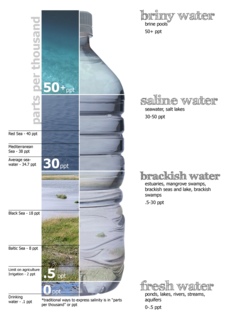
Back بحيرة مالحة Arabic Llagu saláu AST Mineral göl Azerbaijani Soizsä BAR Мінеральнае возера Byelorussian Солено езеро Bulgarian Llac salat Catalan Slané jezero Czech Saltsø Danish Salzsee German
| Part of a series on |
| Water salinity |
|---|
 |
| Salinity levels |
|
Fresh water (< 0.05%) Brackish water (0.05–3%) Saline water (3–5%) Brine (> 5% up to 26%–28% max) |
| Bodies of water |

A salt lake or saline lake is a landlocked body of water that has a concentration of salts (typically sodium chloride) and other dissolved minerals significantly higher than most lakes (often defined as at least three grams of salt per liter).[1] In some cases, salt lakes have a higher concentration of salt than sea water; such lakes can also be termed hypersaline lake, and may also be pink lakes on account of their color. An alkalic salt lake that has a high content of carbonate is sometimes termed a soda lake.[2]
Salt lakes are classified according to salinity levels. The formation of these lakes is influenced by processes such as evaporation and deposition. Salt lakes face serious conservation challenges due to climate change, pollution and water diversion.
- ^ "Physical Characteristics of Great Salt Lake". learn.genetics.utah.edu. Retrieved 2024-11-16.
- ^ Hammer, U. T. (1986-04-30). Saline Lake Ecosystems of the World. Springer Science & Business Media. p. 15. ISBN 978-90-6193-535-3.